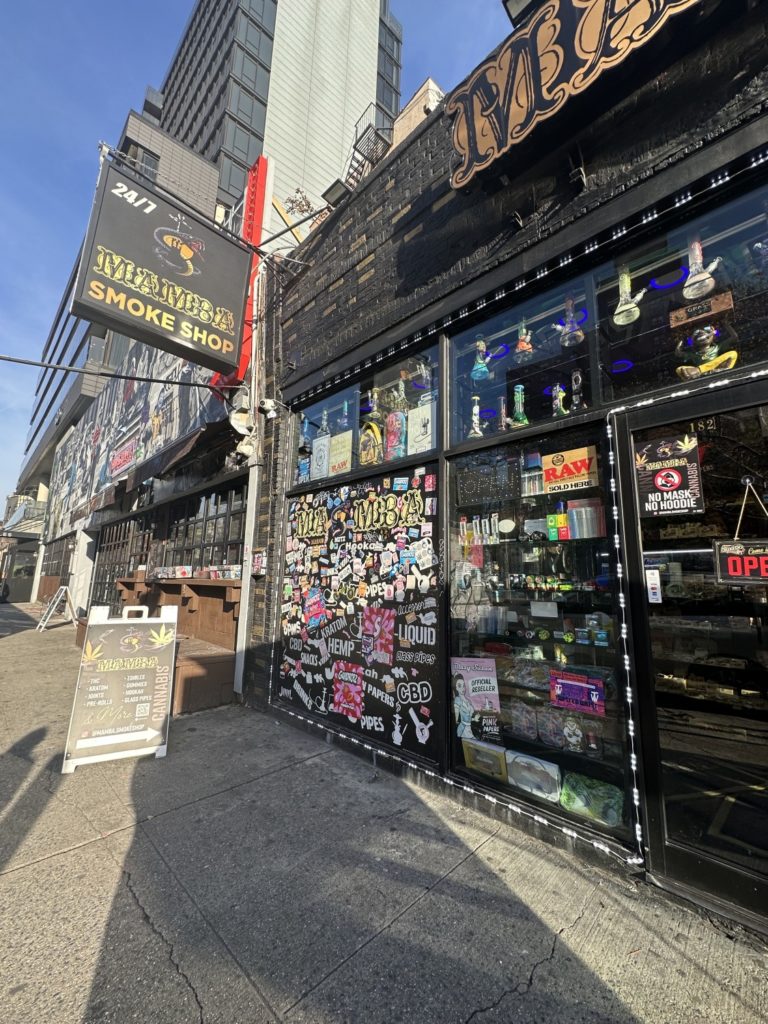A heap of pot from California and other states is fueling sales in the five boroughs at a time when pretty much everything else is more expensive.
Empire Cannabis Club has a flagship store in New York City’s trendy Chelsea neighborhood.
Photographer: Paulina Cachero
It’s never been easier to get weed in New York.
Dealers openly hawk bud, vapes and edibles from tables in Union Square. Bodegas advertise marijuana in their windows. Even holiday markets have weed vendors alongside the jewelry and Christmas ornaments.
Marijuana has been legal in New York for almost two years, but licensed stores haven’t opened yet. In the meantime, weed has flooded into the city and is sold openly across the five boroughs. And the laws of supply and demand are working: Pot prices are falling at a time when everything from groceries and rent to electric bills and nights on the town have gotten more expensive.
Joe Camerota remembers the days when a delivery guy would charge him $50 for less than an eighth of an ounce. Today, dealers approach the 39-year-old comedian when he smokes pot on the stoop of his Brooklyn home and make him offers he thought he’d never see: $80 for a full ounce, or just $10 for an eighth.
“All of a sudden, I have dudes coming up to me asking me how much I’m paying for an ounce and saying they could beat it,” Camerota said. “This year, the price of everything has gone up — except for weed and Arizona Iced Tea.”
Weed has long been available in New York City, with delivery services and street dealers for buyers willing to dabble in the illicit economy. New York is now one of 21 states that have legalized recreational cannabis use, but licensed dispensaries in the state aren’t expected to open until 2023. That gap has allowed gray-market dealers to proliferate while legal stores wait on the sidelines.
Meanwhile, a glut of pot grown in California, which some illicit sellers refer to as the “Federal Reserve” for cannabis, has pushed wholesale prices down 60% from a peak in the fall of 2020, including a 36% drop in the past year, according to data analytics firm Cannabis Benchmarks.
‘Spending Way Less’
On a recent trip to the Lower East Side, where bongs and pipes decorate numerous storefronts, the going rate for an eighth starts as low as $30 for medium-quality strains. Pre-rolls and vape cartridges under $20 are sold at corner bodegas. And word on the street is that dealers uptown have cannabis products starting at $8.
“If you’re running a shop, you have to be aware of what the prices are from the guy selling on the street at Washington Square Park to be competitive,” said Adam Koh, the editorial director of Cannabis Benchmarks.
NYC Weed Dodges Inflation
A smoke shop in New York City’s Lower East Side displays marijuana paraphernalia from banana bongs to petite glass pipes.
For Nami Saito, the lower prices mean major savings. In 2020, the 26-year-old would spend $50 for an eighth with a $120 minimum purchase through one of the city’s black-market delivery services. Now, she can get the same amount of pot and a free pre-roll for just $30 at the smoke shop down the street in Chinatown.
“I’m spending way less on weed than I did last year and I’m smoking the same amount,” said Saito, who spends $120 a month on marijuana — the same amount she used to spend in a week. “I swear the eighths are bigger now, and it’s cheaper.”
The low prices and proliferation of sellers is putting the legal market at a disadvantage before it even gets going. While authorities have vowed to crack down on the unlicensed stores, the gray market will be difficult to get under control. Cannabis Benchmark’s Koh estimates that New York state’s legal recreational sales will amount to just $1.5 billion of the estimated $7 billion total market in 2023.
This isn’t a new phenomenon. Gray markets exploded in other jurisdictions, such as California and Canada, after legalization but before authorities could establish retail regulations. Just like what’s happening now in New York, there were long stretches when pot was legal to possess and consume, but there was no way to legally purchase it.
“It’s not that the cannabis market is booming — it’s being infiltrated by the illicit market before the licensed stores open up,” said Matt Hawkins, founder of cannabis venture firm Entourage Effect Capital.
‘Unlevel Playing Field’
At Empire Cannabis Club in Chelsea, there’s a constant stream of customers at 4 p.m. on a recent Thursday. They’re greeted by specialized “budtenders” who take them through a variety of premium California products displayed in glass cases.
NYC Weed Dodges Inflation
Customers at Empire Cannabis Club are greeted by “budtenders” who show them a selection of premium weed.
The slump in California wholesale prices has allowed Empire to regularly offer discounted ounces for as little as $185, or $23 for an eighth. A Black Friday sale had ounces going for $100.
The growing number of shops like Empire has left legal cannabis operators on an “unlevel playing field,” said Matt Darin, chief executive officer of Curaleaf, a Massachusetts-based pot company that operates in multiple states, including medical dispensaries in New York.
“New York has an illicit market that has been unenforced and allowed to proliferate,” said Darin. “It’s setting up the legal market for failure.”
The battle between the legal and gray markets is likely to continue even once the regulated stores open. Licensed dispensaries will be subject to taxes, compliance costs and restrictions on sales. And while they tout that their products are safe and tested, the prices will almost certainly be higher than what people find on the street. For Saito, that’s likely a deal breaker.
“What’s the point of going out of my way to buy legal weed if it’s going to be more expensive? I’d rather support local plugs,” Saito said.
H/T: www.bloomberg.com



